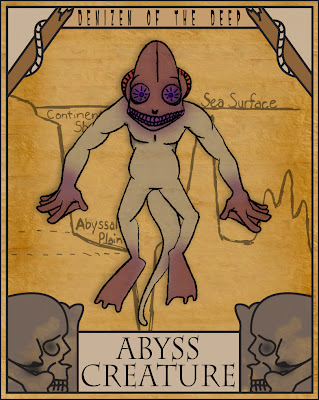Name: Ceryutian
AKA: Unknown
Location: Show Low, Arizona (originating from the fourth planet from the eighth star in the L'Sariax Sector)
Novel: Jed the Dead
Author: Alan Dean Foster
Natural History:
The Ceryutians were massive aliens who probably weighed three or four hundred pounds and were seven feet tall. They had thick muscular legs, which were jointed at the knee, front and back. Far slimmer arms reached to the ground. The long arms ended into a dozen flexible digits eight to nine inches in length. The digits resembled tentacles.
Their heads were rectangular in shape with large oval eyes. Below the eyes was a down-curving, wide mouth. No nostrils were visible and what appeared to be ears reached over the top of their heads.
The Ceryutians carried packs on their backs that had hoses on the end. These packs probably contained whatever gases they needed to breath, as they would bring the hoses up to their mouths occasionally. On their legs they had what looked like tapered gallon jugs. These jugs were weapons that would cause invisible explosions wherever they were aimed.
The Ceryutians came to Earth when a group of cultists used Jed as a type of beacon when performing a ritual. The first contact between man and alien was a swift kick to the crotch.
AKA: Unknown
Location: Show Low, Arizona (originating from the fourth planet from the eighth star in the L'Sariax Sector)
Novel: Jed the Dead
Author: Alan Dean Foster
Natural History:
The Ceryutians were massive aliens who probably weighed three or four hundred pounds and were seven feet tall. They had thick muscular legs, which were jointed at the knee, front and back. Far slimmer arms reached to the ground. The long arms ended into a dozen flexible digits eight to nine inches in length. The digits resembled tentacles.
Their heads were rectangular in shape with large oval eyes. Below the eyes was a down-curving, wide mouth. No nostrils were visible and what appeared to be ears reached over the top of their heads.
The Ceryutians carried packs on their backs that had hoses on the end. These packs probably contained whatever gases they needed to breath, as they would bring the hoses up to their mouths occasionally. On their legs they had what looked like tapered gallon jugs. These jugs were weapons that would cause invisible explosions wherever they were aimed.
The Ceryutians came to Earth when a group of cultists used Jed as a type of beacon when performing a ritual. The first contact between man and alien was a swift kick to the crotch.
"Hey, if you'd seen a Ceryutian before you wouldn't have to ask. They're famous for their tempers. It was bad enough to draw them off course, but the fact that it was to a backwater primitive world like Earth made it much worse."

































